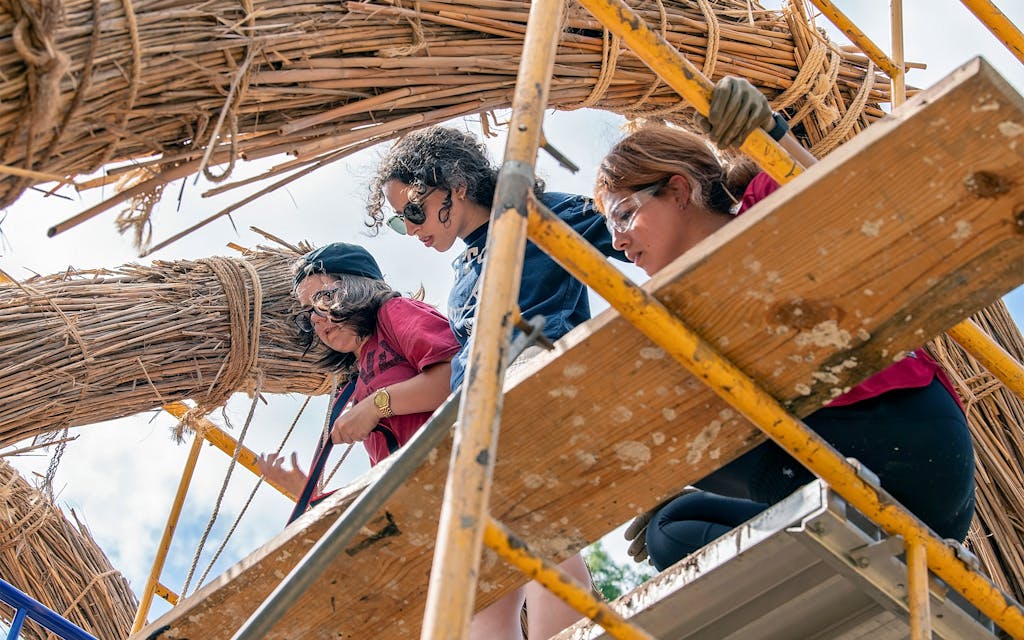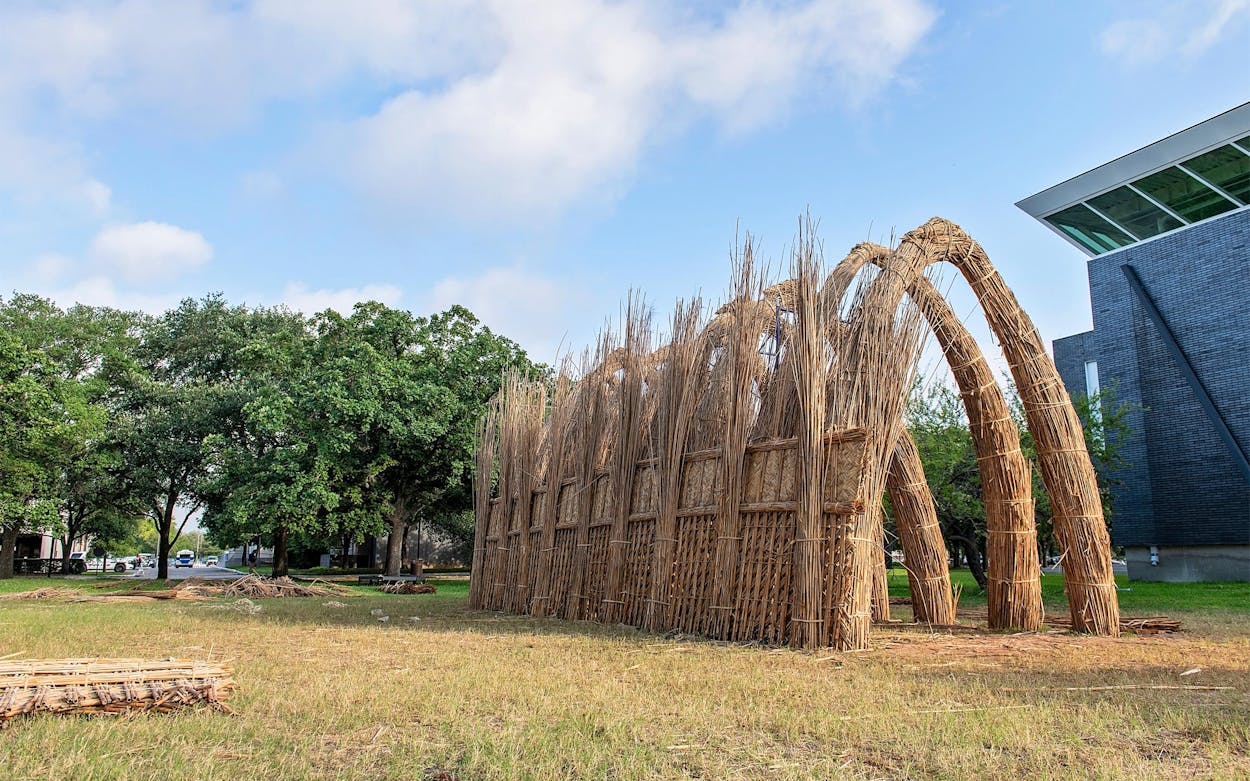In the middle of a Texas heatwave rivaling temperatures in the Persian Gulf and Sahara Desert, an Iraqi man and two women stood on scaffolding, attempting to make one of nine arches constructed entirely of reeds look a little prettier. They were trying to perfect the round crown of the arch, and after some phone calls to a master builder in Iraq, like a son calling their mom for help with a recipe, questions were answered, and they made more progress. In the cooler evenings, solar beatdowns were replaced by a more jovial scene of music and food as Iraqi immigrants in Houston came by to help construct the five-thousand-year-old structure known as a mudhif. Here, past the oak-lined one-ways of Rice University, next to its Moody Center for the Arts, local nonprofits have teamed up to put the culture of the Marsh Arabs on display.
“Now a Mudhif you can’t picture till you’ve seen it,” wrote Gertrude Bell, the so-called female Lawrence of Arabia, more than a hundred years ago. The mudhif, a town hall of sorts that has been depicted on temple walls and other artifacts dating back to 3200 BC, is made entirely out of reeds from the marshlands between the Tigris and Euphrates rivers in Iraq. To see a mudhif in its natural habitat would mean traveling roughly 7,500 miles to the ancient lands of Mesopotamia—the cradle of Abrahamic religions, writing, and the first cities—to a delta and its shallow waters once believed to be the Garden of Eden. There, an estimated 250,000 Indigenous people live on artificial islands built of reeds and mud, in houses made from the same reeds.

Instead of traveling across the globe, the Houston nonprofit Archaeology Now and the Arab-American Educational Foundation developed the Marsh Arab Project for the sake of cultural preservation and ecological education. Director Becky Lao and her team at Archaeology Now wanted to bring awareness to the Marsh Arabs under a simple belief that “people need to experience a mudhif.” Thanks to a board member with Rice connections, bringing this ancient form of green, Indigenous construction to the university famous for its engineering and architecture schools was a no-brainer.
“There is nothing more symbolic of the meaning of the Arab Marsh culture than the mudhif,” said Azzam Alwash, the man on the scaffolding and the cofounder of an Iraqi NGO dedicated to preserving the country’s natural environment and culture. The mudhif is designed to settle disputes, host guests, and unite the community in celebration. “It’s a structure that is built from reeds—bundles of reeds, ropes of reeds, reeds upon reeds, and nothing but reeds. It’s one of the more sustainable structures that exist,” said Alwash, who was also the personal climate adviser to former Iraqi president Barham Salih.
Once the third-largest wetland in the world, the freshwater ecosystem between the Tigris and Euphrates was home to half a million Marsh Arabs in the 1950s. Their civilization resembles a rural, decentralized version of the floating Tenōchtitlan in Lake Texcoco, or a version of Venice, boats and all, minus the brick, stone, and wood.
Before human interference, snow from the mountains of Kurdistan melted in the late spring. The ensuing floods of the Tigris and Euphrates cleansed the soil by moving brackish water and fertilized the farmland with deposits of clay and silt. The wetlands are the result of this overflowing and act as a natural water-retention system. The reeds absorb water in marshes during periods of heavy rainfall and slowly release it into waterways. The Marsh Arab way of life fit harmoniously into this millennia-old natural order.
In the 1980s, under the rule of Iraqi dictator Saddam Hussein, that lifestyle became endangered. During the Iran–Iraq War and especially after the failed Shiite uprising following the Gulf War in 1991, Saddam’s government sought the destruction of the refuge of the Marsh Arabs. Unleashing fighter jets, his forces bombed and torched houses, slaughtered their cattle, poisoned their water to eradicate fish, and arrested, tortured, and executed them. Hussein also weaponized water: Throughout the nineties, his government built and humbly named canals—Saddam River, Glory Canal, Loyalty to the Leader Channel, among others—that diverted water from overflowing the marshes and instead emptied it into the Persian Gulf. They drained roughly 90 percent of the wetlands and displaced nearly half of the entire population. Eden became a desert.


Though the mudhifs and the reeds are “only a symbol,” Alwash says, they represent all that can be gained and lost from the marshes, “a link to our common history.” The Houston project will earn the title of first mudhif built in Texas and the second in the country. (The first, much smaller, was constructed in 2021 in Philadelphia by local artists, who used it to bring together Iraqi immigrants and American veterans for reconciliation sessions. The Rice structure is the first to involve a master builder.)
The search to find the master builder—a credential earned after fifteen to twenty years of making mudhifs—was long. In the face of logistical issues, including the inability to bring master builder Meer Al Asadi stateside, the organizers came up with the next best solution: a “Lego set for mudhifs.” Alwash and the team resorted to gathering reeds in the Iraqi marsh. Al Asadi constructed the components—reed bundles for the arches, woven mats for the floors and walls—and loaded them into a shipping container for transport from the port of Umm Qasr in Iraq to the Port of Houston, where after many delays in global transit they remained for inspections, X-rays, and fumigation. “It turns out exporting reeds from Iraq is more difficult than smuggling oil,” Alwash joked.
While the lifeblood of the Marsh Arabs was being collected in Iraq, volunteers with the Arab-American Educational Foundation and Archaeology Now collected the very same reeds in our own backyard, where they’re considered invasive. The Houston-collected reeds will be used in activities for field trips from local schools. The mudhif will also host late-night parties and visitors from outside the university. Come fall, it will house classes for Rice architecture, engineering, history, and environmental studies students. The building process is being filmed for an archival documentary by Rice students, powered by a grant from the city of Houston, because “knowledge of how to build this structure has almost disappeared,” Lao said.
For Iraqis in Houston, the project strikes a chord. Kadum Jahlul, a 52-year-old who came to Dallas in 1992 and Houston three years later, was moved upon hearing of the project and the memories of his nine-year-old self it elicited—of living not in but next to the marshes, playing with friends near the river, and eating biryani and masgouf (grilled fish, considered the national dish of Iraq) in a mudhif every Friday. Ghaidaa Makki, an Iraqi-born dentist and a board member of the Arab American Cultural and Community Center, left Baghdad for Houston in 2006 after the threat of car bombings came too close to home—one killed a neighbor. But now, Makki is experiencing the mudhif and what it represents—“a part of my country that I’ve never been to, coming here to my home city”—alongside her three children.
Alwash has memories from childhood of experiencing the “warm, safe glow” of the “water world” in a small boat with his father. “I remember the beauty of nature, but I also remember looking down upon people who were barefoot, walking in the mud, wearing dirty clothes,” Alwash said, who regrettably, he says now, reduced the Marsh Arab community to “hicks” and “rednecks” when he was a kid. “I really did not understand the importance of this culture until I stepped away and went to United States and lived here for 25 years,” he said. “Today I look at these same people as people who live in complete harmony with their environment,” he said. “Their definition of happiness is different than our definition of happiness. Not that one is better than the other. It’s just different.”
- More About:
- Style & Design
- Rice University
- Architecture
- Houston






